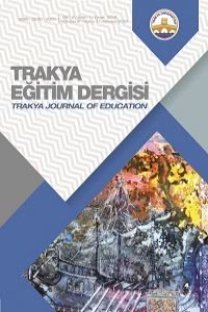Özel Yetenekli Öğrencilerin FeTeMM’in Mühendisliği Hakkındaki İmajları
Bu araştırma Türkiye’de öğrenim gören ortaokul seviyesindeki bir grup özel yetenekli öğrencinin mühendis/mühendislik algılarını ortaya çıkarmak için yapılmıştır. Temel nitel araştırma olarak yürütülen bu çalışmaya Türkiye’deki Bilim Sanat Merkezlerinden birinde öğrenim gören 72 (26 kız, 46 erkek) öğrenci katılmıştır. Veriler, kişisel bilgiler formu, “Bir Mühendis Çiz Testi (BMÇT)” ve çizimler hakkında gerçekleştirilen görüşmeler aracılığıyla toplanmıştır. Toplanan veriler içerik analizine tabi tutulmuştur. Sonuç olarak katılımcıların çoğunun mühendisliğin tasarım boyutuna değindikleri ve inşaat mühendisi çizdiği görülmüştür. Ayrıca araştırmaya katılan öğrencilerin, mühendisliği erkek mesleği olarak algıladıkları ortaya çıkmıştır. Özel yetenekli öğrencilerin eğitiminde öğrenme ortamları, öğrencilerin mühendisliğe ilişkin algılarını ve yeteneklerini geliştirilecek şekilde düzenlenebilir.
___
- ABET. (2003). CriteriaforAccreditingPrograms. http://www.abet.org/criteria_eac.htm 28 p.
- Adams, C., Chamberlin, S., Gavin, M. K., Schultz, C., Sheffield, L. J., & Subotnik, R. (2008). The STEM promise: recognizing and developing talent and expanding opportunities for promising students of science, technology, engineering and mathematics. Washington, DC: Math / Science Task Force, NAGC.
- Belet Ş. D., & Türkan, B. (2007). İlköğretim öğrencilerinin yazılı anlatım ve resimsel ifadelerinde algı ve gözlemelerini ifade biçimleri (Avrupa birliği örneği). VI. Ulusal Sınıf Öğretmenliği Eğitimi Sempozyumu (27-29 Nisan 2007) Bildiriler Kitabı, Ankara: Nobel Yayın Dağıtım.
- Bilen, K., Irkıçatal, Z., & Ergin, S. (2014). Ortaokul öğrencilerinin bilim insanı ve mühendis algıları. XI. Ulusal Fen Bilimleri ve Matematik Eğitimi Kongresi Bildiri Özetleri Kitapçığı, 11-14 Eylül, 2014.
- Capobianco, B. M., Diefes-Dux, H. A., Mena, I., & Weller, J. (2011). What is an engineer? implications of elementary school student conceptions for engineering education. Journal of Engineering Education, 100(2), 304-328.
- Cunnignham, C. M., Lachapelle, C., & Lindgren-Streicher, A. (2005). Assessing elementary school students’ conceptions of engineering and technology. Proceedings of the 2005 American Society for Engineering Education Annual Conference & Exposition.
- Dejarnette, N.K. (2012). America’s children: providing early exposure to STEM (Science, Technology, Engineering and Math) initiatives. Education, 133(1), 77-84.
- Fralick, B., Kearn, J., Thompson, S., & Lyons, J. (2009). How middle schoolers draw engineers and scientists. Journal of Science Education and Technology, 18(1), 60-73.
- Grubbs, M. (2013). Robotics intrigue middle school students and build STEM skills. Technology and Engineering Teacher, 72(6), 12-16.
- International Technology Education Association (ITEEA). (2009). The overlooked STEM imperatives: Technology and engineering. Reston, VA: Author.
- Johnson, A. P. (2014). Eylem araştırması el kitabı (Y. Uzuner, & M. Özten Anay, Çev.). Ankara: Anı.
- Karataş, F. O., Micklos, A., & Bodner, G. M. (2011). Sixth-grade students’ views of the nature of engineering and images of engineers. Journal of Science Education and Technology, 20(2), 123-135.
- Katzenmeyer, C., & Lawrenz, F. (2006). National science foundation perspectives on the nature of STEM program evaluation. New Directions for Evaluation, 109, 7-18.
- Kearney, S. K., & Hyle, E. A. (2004). Drawing out emotions: the use of participant produced drawings in qualitative inquiry. Qualitative Research, 4(3), 361-382.
- Khandani, S. (2005). Engineering design process. Unpublished Education Transfer Plan, Department of Mechanical Engineering, Massachusetts Institute of Technology.
- Knight, M., & Cunningham, C. (2004). Draw an engineer test (DAET): Development of a tool to investigate students’ ideas about engineers and engineering. Paper presented at the ASEE Annual Conference and Exposition, Salt Lake City, UT.
- Lyons, J., & Thompson, S. (2006). Investigating the long-term impact of an engineering based GK-12 program on students’ perceptions of engineering. Paper presented at the ASEE Annual Conference and Exposition.
- Mann, E. L., Mann, R. L., Strutz, M. L., Duncan, D., & Yoon, S. Y. (2011). Integrating engineering into K-6 curriculum: developing talent in the STEM disciplines. Journal of Advanced Academics, 22(4), 639-658.
- MEB. (2007). Milli Eğitim Bakanlığına Bağlı Okul ve Kurumlarda Yapılacak Araştırma ve Araştırma Desteğine Yönelik İzin ve Uygulama Yönergesi. http://mevzuat.meb.gov.tr/html/2594_1.html adresinden alınmıştır.
- MEB. (2015). Milli Eğitim Bakanlığı Bilim ve Sanat Merkezleri Yönergesi. http://orgm.meb.gov.tr/meb_iys_dosyalar/2015_09/18101802_bilimvesanatmerkezleriynergesi.pdf adresinden alınmıştır.
- Melanlıoğlu, D. (2015). Ortaokul öğrencilerinin Türkçe dersi algılarına yönelik yaptıkları çizimler. Okuma Yazma Eğitimi Araştırmaları, 3(1), 27-38.
- Merrill, C. (2009). The future of TE masters degrees: STEM. Presentation at the 70th Annual International Technology Education Association Conference, Louisville, Kentucky.
- Merriam, S. B. (2013). Nitel araştırma desen ve uygulama için bir rehber (S. Turan, Çev.). Ankara: Nobel.
- NRC. (1996). National science education standards. Washington DC:The National Academic Press.
- National Research Council (NRC). (2000). Inquiry and national science education standarts. Washington, DC: National Academy.
- Oware, E., Capobianco, B., & Diefes-Dux, H. (2007). Gifted students’ perceptions of engineers a study of summer outreach program. American Society for Engineering Education.
- Patton, M. Q. (2002). Qualitative research & evaluation methods. Thousand Oaks, CA: Sage.
- Silver, A., & Rushton, B. S. (2008). Primary-school children's attitudes towards science, engineering and technology and their images of scientists and engineers. Education 3, 13. 36(1), 51-67.
- Thompson, S., & Lyons, J. A. (2005). A study examining change in underrepresented student views of engineering as a result of working with engineers in the elementary classroom. Paper presented at the ASEE Annual Conference and Exposition.
- Yıldırım, A., & Şimşek, H. (2006). Sosyal bilimlerde nitel araştırma yöntemleri. Ankara: Seçkin.
- Zians, A. W. (1997). A qualitative analysis of how experts use and interpret the kinetic school drawing technique. Yayımlanmamış Yüksek Lisans Tezi, Toronto Üniversitesi, Kanada.
- URL-1-www.mühendis.nedir.com
- URL-2-http://www.balarilarimuhendisoluyor.com/
- ISSN: 2630-6301
- Yayın Aralığı: Yılda 3 Sayı
- Başlangıç: 2011
- Yayıncı: Trakya Üniversitesi Eğitim Fakültesi
Sayıdaki Diğer Makaleler
Kamu Ortaöğretim Okulu Müdürlerinin Hukuksal Yetkilerini Kullanımına İlişkin Görüşleri
Duygu ANIL, Melike ÖZER, Begüm ÖZTEMÜR
Meltem ACAR GÜVENDİR, Emre GÜVENDİR
Emine AHMETOĞLU, Vahdet GÖRMEZ, Murat COŞKUN, Mücahit ÖZTÜRK, Muhlise COŞKUN ÖGEYİK
Penn Etkileşimli Akran Oyun Ölçeği Öğretmen Formunun Uyarlama Çalışması
Emine AHMETOĞLU, İbrahim Hakkı ACAR, Neriman ARAL
Eğitimde Neoliberal Yerelleşme ve Eleştirisi
Öğretmen Adaylarının Ölçme ve Değerlendirmeye Yönelik Yeterlik Algılarının İncelenmesi
Dijital Öykü Temelli Değerler Eğitimi Materyallerinin Öğrencilerin Değer Kazanımına Etkisi
Bünyamin ATICI, Süleyman Eren YÜRÜK
